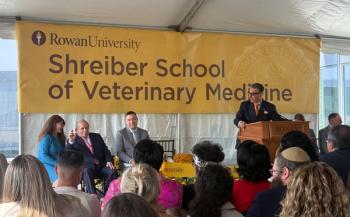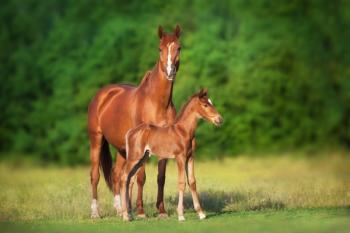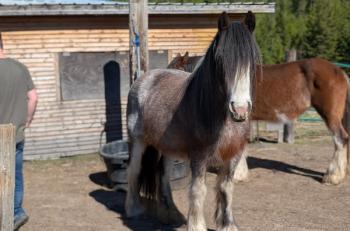
Diagnosing fatal sinker syndrome and implementing treatment Plan A
Part 4 in a series on understanding the disease progression of abnormal hoof anatomy.
If there is an area in the study of laminitis that requires dedicated research, fatal sinker syndrome is at the top of my list. This syndrome can strike without warning in hours or weeks. It might give you clues of its onset or it might not. It can be slow and insidious or a horse can suddenly walk out of its hooves.
Fatal sinker syndrome is an uncommon form of Grade IV laminitis. Usually it is a few weeks in the making and occurs after rotational laminitis. However, fatal sinker syndrome does not have to follow the rules and can occur within 24 hours of the acute phase of a laminitic bout. The syndrome can occur in one or all four feet.
Clients must be alerted to the grave prognosis of fatal sinker syndrome and the extensive rehabilitation and cost of correction. Pain management will not help or halt progression if it is used as the sole therapy. Casting with or without transcortical pinning and hoof wall ablation is the most common technique applied.
Pathogenesis of fatal sinker syndrome
We do not know what catastrophic mechanism causes fatal sinker syndrome, but we do know that the end result is entire circulatory collapse with subsequent laminar necrosis and loss of the hoof capsule. Severe systemic illness such as pleuropneumonia, metritis, enteritis, colitis or any endotoxemic event is the cause of most cases of fatal sinker syndrome. The worst cases I have seen involved mares with retained placenta that developed metritis.
I have also seen fatal sinker syndrome as a sequela to supporting limb laminitis. These cases do not have the terrible endotoxin challenge but are instead an overloading and circulatory compression problem—usually affecting one foot—and have a better prognosis if treated immediately.
Fatal sinker syndrome can also be caused by excessive concussion after exertion (e.g., galloping on hard surfaces), infections of the distal interphalangeal joint, excessive grain consumption with subsequent renal failure, and compromised immune systems after exogenous challenge, such as in the use of high-dose corticosteroid treatment.
Radiographic diagnosis
Figure 1 shows the measurement protocol for hoof abnormalities. A rotational laminitic case (as opposed to fatal sinker syndrome) has an increased horn-laminar zone (HLZ), an increased positive palmar angle (PA), an increased extensor process-coronary band (EP/CB) as the extensor process moves downward in the hoof capsule (as opposed to the entire distal displacement of the third phalanx [P3] that occurs in fatal sinker syndrome), a decreased sole depth under the tip of P3 (SDT) and an increased sole depth at the wing of P3 (SDW).
Figure 1: The measurement protocol used to measure hoof abnormalities: HLZ (horn-laminar zone), PA (palmar angle), EP/CB (extensor process-coronary band), SDT (sole depth under the tip of P3), SDW (sole depth at the wing of P3) and W/B (wing-to-bulb measurement). (Photos courtesy of Andrea Floyd, DVM)
As you obtain the recommended weekly lateral radiographs of your laminitic cases, you will be observing the changes that take place over the four- to six-week span of the degenerating progression of the disease. Ideally you have jumped on the case at its onset and biomechanically halted the pull of the deep flexor on the P3. Typically over the four- to six-week period, improvements in the SDT, the PA, the heart rate and the horse's pain levels are noted.
In horses with fatal sinker syndrome, however, the values will change. The heart rate will increase (80 to 100 beats/min), and the horse will become recumbent (Figure 2) unless it has a foal by its side, in which case the mare may not lie down until it is too late.
Figure 2: The typical recumbent pose of a horse with fatal sinker syndrome, an uncommon form of Grade IV laminitis that can strike suddenly.
Measurements will also change strikingly. Radiographically, the P3 may appear to be going back to its normal position within the hoof capsule. In actuality, you may be witnessing the loss of all soft tissue architecture and the collapse of the P3 within the soft tissue (lamina and bulbar tissue). A halo or lucency throughout the coronary band may be observed on radiographs (Figure 3). A ledge above the coronary band may also be seen (Figure 4).
Figure 3: A lateral radiograph showing a halo and ledge at the coronary region (white arrow).
When all these changes occur, the SDT decreases, the SDW decreases, the EP/CB increases, the HLZ increases and the PA decreases as the P3 starts its slide down and back within the hoof capsule. The SDT and SDW may appear nearly the same. Venography will likely reveal proximal displacement of the circumflex vessels and leakage of contrast material into the surrounding lamina. Accurate records of your measurements are therefore critical for prognostic purposes.
Figure 4: A swollen coronary band before hoof wall avulsion becomes obvious.
The wing-to-bulb measurement (W/B) is another measurement I add to my protocol. This measurement is taken from the most palmar aspect of the P3 wing in a straight line to the bulb of the heel (Figure 1). Be sure you use the same points for measurement on each radiograph or you may misinterpret your findings. In the course of your evaluations, if this measurement decreases, you may need to obtain radiographs repeatedly at 24-hour intervals to see if there has been further decrease. Fatal sinker syndrome cases typically slide back within the hoof capsule, and the W/B measurement will show this impending problem.
I watch all parameters carefully for the first four to six weeks of new case admissions. If a horse presents with or develops swelling around the entire circumference of the coronary band or starts to swell in the pastern region, immediately repeat venography and start sequential cryocompression therapy. Once the swelling has stopped, perform another venographic study to determine whether normal blood flow has returned. If blood flow is still compromised, then it is time to discuss Plan A or Plan B with your client (see below).
Note that all venograms should be obtained on a standing horse that is loading the foot being radiographed.
External signs of fatal sinker syndrome
Externally, horses with fatal sinker syndrome will show several signs. The hoof capsule may appear dry and friable. The entire sole will appear flat and collapsed. The hair above the coronary band will stick straight out or up, depending on how far the articular column has sunk into the hoof capsule.
Figure 5: A typical coronary band shear.
A sunken area or ledge above the coronary band will be noted all the way around the foot except in the bulbar area. The ledge will correlate with the change in the hair pattern. The coronary band will swell (Figure 4). A dry crack or shear lesion will follow as a sequela to the sunken ledge (Figure 5). The soft tissue of the bulbs will appear weak visually and palpably and may exude blood, serum or pus.
Figure 6: The coronary band and bulbs that have separated and deformed.
In the final stages, the coronary band will start to separate all the way around the hoof capsule and will, like the bulbs, leak serum, blood or pus (Figure 6). The hoof capsule will shrink as it loses its blood supply, acting like a tourniquet around the internal structures (Figure 7), further worsening the condition and resulting in complete hoof capsule avulsion.
Figure 7: A hoof capsule prior to avulsion that has shrunken around the soft tissue structures, compressing circulation.
Treatment: Plan A vs. Plan B
In the early stages of fatal sinker syndrome, if blood flow—albeit diminished—is still observed in the dorsal, circumflex and bulbar regions of the foot (as observed through your venography study) (Figure 8), then a casting procedure of the foot may be tried—this is your Plan A. The cast is a simple foot cast from the mid-pastern region, incorporating the entire hoof capsule. The cast is applied to a standing, sedated horse.
Figure 8: A lateral venogram of a horse with fatal sinker syndrome that has diminished blood flow and may benefit from a hoof casting procedure. Note the flattened appearance of the bulbar circulation and the complete absence of the circumflex circulation often seen with severe sinkers. Also visible is the dorsal circumflex junction that is contorted from the sinking P3.
Here are the steps for treatment Plan A:
- Create a groove into the hoof wall just distal to the coronary band in the area below the ledge.
- Tape a 0.5-inch-thick-by-1-inch-wide strip of felt to the mid-pastern where your cast will end.
- Apply a second strip of felt to the coronary band.
- Cut a third piece of felt to the size of the solar surface and apply it to the sole. (The coronary band and sole felt may be impregnated with povidone-iodine if you think they will become compromised while in the cast.)
- Apply cast padding to the entire area to be casted. Apply a thin cotton material over the cast padding to make the casting tape easier to remove later.
- Apply fiberglass casting tape. The width of the casting tape depends on the size of the foot to be cast.
- Once the cast has dried, apply a hoof acrylic to the bottom or solar region of the cast to give a slightly domed shape to aid in the mobility of the foot.
Leave the cast on for four weeks and obtain radiographs weekly. Multiple casts will be required. Strict stall rest is required, as in all acute laminitis cases. Should any deterioration in your parameters occur, or should increased swelling, pain or heart rate occur during that time, then the cast needs to be removed and the situation reassessed.
If improvement is not progressive with the simple foot cast, then it may be time for Plan B, which will be discussed in Part 5 of this series.
Andrea E. Floyd, DVM, has specialized in equine podiatry for more than 25 years. She is the owner of Serenity Equine in Evington, Va., and the author of Equine Podiatry. Dr. Floyd is a member of the American Veterinary Medical Association, American Association of Equine Practitioners and the American Farriers Association.
Newsletter
From exam room tips to practice management insights, get trusted veterinary news delivered straight to your inbox—subscribe to dvm360.






